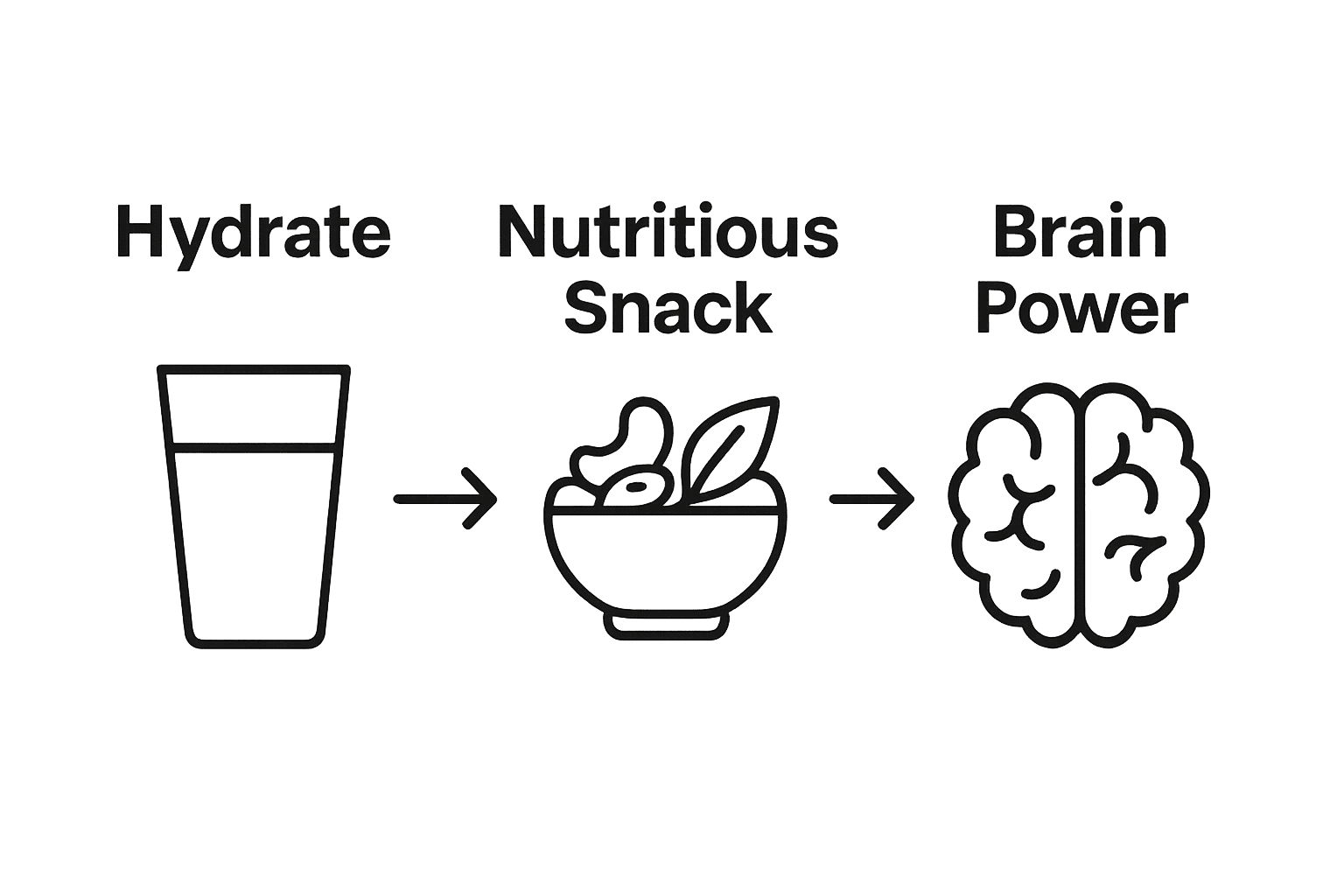Getting better at concentrating sounds simple enough and yet most people feel their focus slipping more each year. Here is something most do not realize. Just being mildly dehydrated can shrink your brain volume and drop your mental performance by as much as 14 percent. People pour hours into the latest productivity hacks but skip the basics that work. The smartest way to boost your focus could actually be far easier than you think.
Table of Contents
- Step 1: Evaluate Your Current Concentration Levels
- Step 2: Create a Distraction-Free Environment
- Step 3: Establish a Regular Mindfulness Practice
- Step 4: Incorporate Healthy Nutrition And Hydration
- Step 5: Experiment With Microdosing Safely
- Step 6: Monitor Progress And Adjust Techniques
Quick Summary
| Key Point | Explanation |
|---|---|
| 1. Evaluate your concentration levels | Assess your cognitive performance using methods like concentration logs or standardized tests. This will establish a baseline for improvement. |
| 2. Create a distraction-free environment | Optimize your physical and digital spaces to minimize interruptions. Use mindful design and manage notifications effectively to enhance focus. |
| 3. Establish a regular mindfulness practice | Engage in consistent mindfulness exercises, focusing on breath or guided meditations, to train your brain to maintain attention and resist distractions. |
| 4. Prioritize healthy nutrition and hydration | Consume nutrient-dense foods and stay hydrated to support brain function and concentration. Balanced meals help stabilize energy levels for sustained focus. |
| 5. Monitor progress and adjust techniques | Use tracking tools to evaluate concentration improvement. Regularly review your data to modify strategies based on what works best for you. |
Step 1: Evaluate Your Current Concentration Levels
Understanding your current concentration baseline is the critical first step in developing a targeted strategy to improve mental focus. Before diving into techniques and interventions, you need an honest assessment of where your cognitive performance currently stands. This evaluation will help you track progress and personalize your approach to concentration enhancement.
To begin your concentration assessment, select a standardized method that provides objective insights into your current mental performance. Learn more about cognitive tracking techniques to support your journey. The Psychomotor Vigilance Test offers a scientifically validated approach for measuring attention and response speed. This brief test helps you identify specific areas where your concentration might be lagging.
Start by creating a detailed concentration log over one week. Track your daily focus patterns, noting specific times when you struggle to maintain attention, situations that interrupt your workflow, and moments of peak mental clarity. Pay attention to how long you can sustain focused work before experiencing mental fatigue. Record the duration of your concentration windows, external distractions encountered, and your subjective energy levels throughout different times of the day.
Key elements to document in your concentration assessment include:
- Total uninterrupted work time
- Number and type of distractions encountered
- Subjective focus quality (scale of 1-10)
- Mental energy levels
- Physical conditions that might impact concentration
After completing your week-long assessment, review the data objectively. Look for patterns in your concentration performance. Are there consistent times of day when your focus drops? Do specific environments or activities contribute to increased or decreased mental clarity? This systematic approach transforms vague feelings about your concentration into concrete, measurable insights that will inform your improvement strategy.
Below is a checklist to help you document your current concentration levels and identify patterns for improvement.
| Assessment Criteria | What to Record | Tracking Frequency | Example Entry |
|---|---|---|---|
| Uninterrupted Work Time | Total minutes spent focused without breaks | Daily | 42 minutes on project work |
| Number & Type of Distractions | Count and describe each interruption | Daily | 5 notifications, 2 conversations |
| Subjective Focus Quality (1-10) | Rate your perception of focus | Several times daily | 7/10 in the late morning |
| Mental Energy Levels | Your self-rated energy for work/study | Morning, Afternoon | Midday slump, high at 10am |
| Physical Conditions Impacting Focus | Note factors like sleep, hunger, environment | As needed | Noisy office, skipped breakfast |
By establishing a clear baseline, you create a personalized roadmap for enhancing your cognitive performance. The data you collect serves as a powerful reference point, allowing you to track improvements and adjust your concentration-building techniques with precision and confidence.
Step 2: Create a Distraction-Free Environment
Crafting an environment that supports sustained concentration is fundamental to improving your mental focus. A distraction-free space acts as the foundation for cognitive performance, allowing your brain to engage deeply with tasks without constant interruption. Your physical and digital surroundings play a critical role in determining your ability to maintain attention.
Explore mindful technology strategies to support your concentration goals. Begin by conducting a comprehensive audit of your work and personal spaces. Identify and systematically eliminate potential sources of interruption. This means addressing both physical environmental factors and digital intrusions that fragment your attention.
Physical space optimization requires intentional design. Choose a dedicated workspace with minimal visual clutter, positioning yourself away from high-traffic areas and potential noise sources. Natural light and comfortable temperature contribute significantly to maintaining mental clarity. Consider noise-canceling headphones if complete silence is unavailable, creating an acoustic barrier that helps you stay focused.
Digital environment management is equally crucial. Implement aggressive notification management across all devices:
- Activate do not disturb modes on smartphones and computers
- Disable social media notifications during work hours
- Use website blockers to limit access to distracting platforms
- Close unnecessary browser tabs and communication applications
Establish clear boundaries with people in your immediate environment. Communicate your need for uninterrupted work time, using visual cues like closed doors or wearing headphones to signal your focus mode. If working in shared spaces, consider using time-blocking techniques that communicate your availability and concentration periods.
Verify the effectiveness of your distraction-free environment by tracking your concentration duration and quality. Notice improvements in task completion speed, reduced mental fatigue, and increased engagement with complex work. A well-designed environment transforms from a passive background to an active support system for your cognitive performance.
Step 3: Establish a Regular Mindfulness Practice
Mindfulness represents a powerful neurological reset button for your concentration capabilities, training your brain to maintain focus and resist mental wandering. Developing a consistent mindfulness practice transforms your cognitive control, allowing you to redirect attention more effectively and build mental resilience against distractions.
Explore holistic approaches to mental wellness that complement your mindfulness journey. Begin with short, achievable meditation sessions that gradually expand in duration. Start with just five minutes daily, preferably at a consistent time to establish a sustainable routine. Morning practice works best for most people, creating a mental foundation before daily challenges emerge.
Choose a meditation style that resonates with your personality and lifestyle. Breath-focused meditation offers an excellent starting point, requiring nothing more than your attention and a quiet space. Sit comfortably, close your eyes, and concentrate on the natural rhythm of your breathing. When thoughts intrude—which they inevitably will—gently redirect your focus back to your breath without self-judgment. This simple practice teaches your brain to recognize and release distracting thought patterns.
The table below summarizes key mindfulness techniques you can incorporate into your daily practice and the potential benefits they offer for concentration.
| Mindfulness Technique | Description | Potential Benefit for Focus |
|---|---|---|
| Breath-Focused Meditation | Focus attention on natural breathing cycle | Trains attention and refocuses mind |
| Body Scan Meditation | Notice sensations throughout the body | Increases body awareness, reduces stress |
| Guided Visualization | Follow audio prompts to imagine calming scenes | Encourages relaxation, eases distractions |
| Walking Meditation | Pay attention to each step/movement | Combines movement with present awareness |
| Loving-Kindness Meditation | Think positive wishes for self/others | Boosts emotional regulation and patience |
| Mindful Breathing Exercises | Practice slow, controlled breaths | Reduces anxiety, recenters attention |
Key mindfulness techniques to incorporate into your practice include:
- Body scan meditation
- Guided visualization
- Walking meditation
- Mindful breathing exercises
- Loving-kindness meditation
Technology can support your mindfulness journey through meditation apps, which provide structured guidance and track your progress. Select applications offering varied session lengths and teaching approaches. Some practitioners find ambient sound backgrounds or gentle guidance helpful when beginning their practice.
Monitor your progress by observing changes in your ability to maintain concentration and emotional regulation. Improved mindfulness manifests through increased patience, reduced reactivity to stressors, and enhanced mental clarity. Consistency matters more than duration—five focused minutes daily will yield more significant results than sporadic, lengthy sessions. Treat your mindfulness practice as a skill to be developed gradually, with compassion and persistence.
Step 4: Incorporate Healthy Nutrition and Hydration
Nutrition and hydration serve as fundamental building blocks for optimal cognitive performance, directly influencing your ability to maintain focus and mental clarity. What you consume profoundly impacts your brain’s capacity to sustain attention and process information efficiently. Treating your body as a high-performance system requires strategic nutritional choices that support neurological function.
Discover strategies for sustainable energy management to complement your nutritional approach. Begin by establishing a hydration baseline of at least eight glasses of water daily, tracking your intake with a dedicated water bottle or smartphone app. Proper hydration supports neurological signaling and prevents the cognitive decline associated with even mild dehydration.
Focus on consuming whole foods rich in nutrients that directly support brain health. Integrate omega-3 fatty acids through wild-caught fish, chia seeds, and walnuts, which help maintain neuronal membrane flexibility and support cognitive processing. Complex carbohydrates from sources like sweet potatoes, quinoa, and berries provide steady glucose release, preventing the mental fog caused by blood sugar fluctuations.
Essential nutritional components for concentration include:
- Lean proteins supporting neurotransmitter production
- Dark leafy greens with brain-protective antioxidants
- Nuts and seeds containing vitamin E
- Fatty fish with omega-3 fatty acids
- Fermented foods supporting gut-brain communication
Timely meal planning becomes crucial for maintaining consistent energy levels. Consume smaller, nutrient-dense meals every three to four hours to prevent energy crashes. Minimize processed sugars and caffeine, which create dramatic performance peaks and valleys. Instead, opt for balanced meals that combine protein, healthy fats, and complex carbohydrates.
Verify your nutritional strategy’s effectiveness by monitoring your energy stability, mental clarity, and concentration duration.

Notice improvements in sustained attention, reduced mid-afternoon fatigue, and more consistent cognitive performance. Remember that dietary changes require patience—give your body several weeks to adapt and optimize its metabolic response to your new nutritional approach.
Refer to this table for meal components that support concentration and their examples to guide your daily nutrition choices.
| Nutrient/Component | Example Foods | Key Benefit for Concentration |
|---|---|---|
| Omega-3 Fatty Acids | Wild fish, chia seeds, walnuts | Supports brain cell flexibility |
| Complex Carbohydrates | Sweet potatoes, quinoa, berries | Steady energy, prevents mental fog |
| Lean Proteins | Eggs, poultry, legumes | Neurotransmitter production |
| Dark Leafy Greens | Spinach, kale | Rich in antioxidants for brain health |
| Nuts & Seeds | Almonds, sunflower seeds | Provide vitamin E for cognition |
| Fermented Foods | Yogurt, kimchi, kefir | Enhance gut-brain communication |

Step 5: Experiment with Microdosing Safely
Microdosing represents a nuanced approach to enhancing cognitive performance, involving controlled consumption of sub-perceptual doses of psychedelic substances to potentially improve focus, creativity, and mental clarity. Responsible experimentation requires meticulous planning, self-awareness, and a comprehensive understanding of potential risks and benefits.
Explore comprehensive microdosing protocols to ensure a structured and informed approach. Begin by thoroughly researching legal considerations, potential interactions with existing medications, and personal health history. Consult healthcare professionals before initiating any microdosing regimen, particularly if you have pre-existing mental health conditions or are taking psychiatric medications.
Develop a systematic tracking methodology to objectively evaluate microdosing effects. Create a detailed journal documenting daily dosage, cognitive performance, emotional state, sleep quality, and any noticeable physiological changes. Use standardized assessment tools like cognitive performance tests or mood tracking apps to quantify potential improvements. Start with the lowest recommended dose, typically 0.1-0.3 grams for psilocybin, and maintain a cautious, incremental approach.
Critical safety considerations for microdosing include:
- Maintaining a consistent, predetermined dosing schedule
- Implementing regular rest periods between microdosing cycles
- Monitoring potential side effects or unexpected reactions
- Ensuring product quality and precise measurement
- Establishing a supportive environment for experimentation
Implement a structured protocol such as the Fadiman method, which involves consuming a microdose every third day to prevent tolerance and minimize potential negative interactions. This approach allows for comprehensive observation of subtle cognitive and emotional shifts while providing adequate recovery time between doses.
This table outlines important safety considerations and strategies for anyone considering microdosing as described in the article.
| Safety Consideration | Description | Recommended Action |
|---|---|---|
| Legal Status | Varies by region/country | Research laws before starting |
| Health History Check | Assess mental health and medication use | Consult a healthcare professional |
| Dose Measurement | Use sub-perceptual quantities (e.g., 0.1-0.3g psilocybin) | Start with the lowest suggested dose |
| Dosing Schedule | Avoid tolerance by spacing doses (e.g., Fadiman method) | Dose every third day, include rest periods |
| Product Quality | Ensure purity and precision | Source from reputable supplier |
| Side Effect Monitoring | Watch for emotional or physical reactions | Keep a detailed journal |
| Supportive Environment | Control conditions to stay safe and comfortable | Prepare the environment in advance |
Verify the effectiveness of your microdosing experiment by assessing objective improvements in concentration, emotional regulation, and overall cognitive performance. Pay attention to qualitative changes in your mental clarity, creative problem-solving abilities, and sustained focus. Remember that individual responses vary significantly, and what works for one person may not produce identical results for another.
Step 6: Monitor Progress and Adjust Techniques
The final stage of improving concentration involves creating a dynamic, responsive system that evolves with your cognitive development. Tracking your progress transforms concentration enhancement from a static strategy into a personalized, adaptive journey. Continuous assessment allows you to understand what techniques work best for your unique neurological profile.
Explore comprehensive tracking methods for personal growth to support your cognitive optimization efforts. Implement a comprehensive tracking system using digital tools or a dedicated journal. Select a consistent method for recording daily concentration metrics, including focus duration, task completion rates, mental clarity, and subjective energy levels. Use standardized assessment tools like cognitive performance tests or mood tracking applications to provide objective measurements.
Design a multi-dimensional tracking framework that captures quantitative and qualitative data. Record not just the duration of your concentration but the quality of your mental engagement. Note environmental factors, nutritional intake, sleep patterns, and stress levels that might influence your cognitive performance. Create a color-coded or numerical rating system that allows you to quickly visualize patterns and correlations between different lifestyle variables and your concentration capabilities.
Key elements to document in your progress tracking include:
- Daily focus duration and intensity
- Specific techniques used and their perceived effectiveness
- Energy levels and mental clarity
- External factors affecting concentration
- Emotional state and stress levels
Schedule monthly review sessions to analyze your tracking data comprehensively. Look for emerging patterns, identify consistent obstacles, and celebrate incremental improvements. Be prepared to modify your approach based on empirical evidence rather than subjective impressions. Some techniques might require weeks of consistent practice before showing meaningful results, so patience and objective assessment are crucial.
Successful progress monitoring means developing the flexibility to experiment, the objectivity to evaluate honestly, and the courage to adjust your strategies. Recognize that concentration improvement is a personalized journey with unique challenges and opportunities. Your ultimate goal is creating a responsive, adaptive system that continuously refines your cognitive performance.
Unlock Lasting Focus With Natural Microdosing Solutions
If you are tired of cycling through concentration tips and still battling distractions, it is time to find a more sustainable path to mental clarity. The article above explores the journey of improving focus with methods like mindfulness and healthy eating, but for many, these steps only go so far. If you want a gentle yet powerful way to enhance your cognitive performance, explore how microdosed psilocybin can support your natural growth. With research-backed benefits for attention, mood, and creativity, microdosing may be the missing piece in your strategy. Discover comprehensive microdosing protocols and see how safe, intentional use could bring you closer to your ideal state of focus.

Now is your chance to take the next step beyond theory. Visit Kind Stranger for expertly crafted psilocybin capsules and gummies, designed for those serious about boosting mental clarity. Start your journey with confidence using our harm-reduction resources, step-by-step dosing guidance, and a friendly educational approach. Make the commitment today and turn your goals for sharper concentration into your everyday reality.
Frequently Asked Questions
How can I evaluate my current concentration levels?
To evaluate your concentration levels, create a detailed concentration log over one week. Track your daily focus patterns, noting specific times you struggle to maintain attention, distractions encountered, and subjective energy levels. A standardized method such as the Psychomotor Vigilance Test can also provide insights into your attention and response speed.
What are some effective techniques for creating a distraction-free environment?
To create a distraction-free environment, optimize your physical space by reducing visual clutter and positioning yourself away from noise sources. Additionally, manage your digital environment by activating do not disturb modes, disabling notifications, and using website blockers to limit access to distracting sites.
How does mindfulness practice improve concentration?
Mindfulness practice improves concentration by training your brain to maintain focus and resist mental wandering. Techniques such as breath-focused meditation help you recognize and redirect distracting thoughts, improving cognitive control and emotional regulation over time.
What role does nutrition play in concentration enhancement?
Nutrition plays a crucial role in concentration enhancement as what you consume impacts your brain’s function. Focus on a diet rich in whole foods, including omega-3 fatty acids, lean proteins, and complex carbohydrates. Proper hydration is also essential for maintaining mental clarity and cognitive performance.


Comments
There are no comments yet.